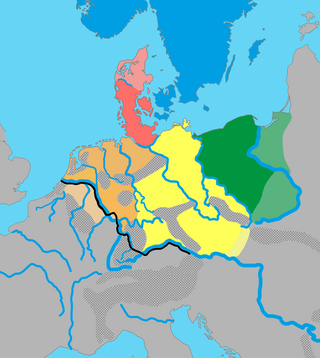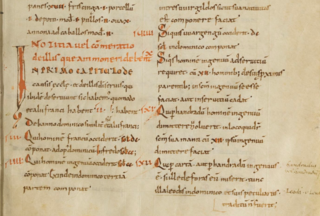Related Research Articles

Weregild, also known as man price, was a precept in some historical legal codes whereby a monetary value was established for a person's life, to be paid as a fine or as compensatory damages to the person's family if that person was killed or injured by another.

The Salic law, also called the Salian law, was the ancient Frankish civil law code compiled around AD 500 by the first Frankish King, Clovis. The written text is in Late Latin and contains some of the earliest known instances of Old Dutch. It remained the basis of Frankish law throughout the early Medieval period, and influenced future European legal systems. The best-known tenet of the old law is the principle of exclusion of women from inheritance of thrones, fiefs, and other property. The Salic laws were arbitrated by a committee appointed and empowered by the King of the Franks. Dozens of manuscripts dating from the sixth to eighth centuries and three emendations as late as the ninth century have survived.

The Istvaeones were a Germanic group of tribes living near the banks of the Rhine during the Roman Empire which reportedly shared a common culture and origin. The Istaevones were contrasted to neighbouring groups, the Ingaevones on the North Sea coast, and the Herminones, living inland of these groups.

Ripuarian is a German dialect group, part of the West Central German language group. Together with the Moselle Franconian which includes the Luxembourgish language, Ripuarian belongs to the larger Central Franconian dialect family and also to the linguistic continuum with the Low Franconian languages.

The Salian Franks, also called the Salians, were a northwestern subgroup of the early Franks who appear in the historical record in the fourth and fifth centuries. They lived west of the Lower Rhine in what was then the Roman Empire and today the Netherlands and Belgium.

Ripuarian or Rhineland Franks were one of the two main groupings of early Frankish people, and specifically it was the name eventually applied to the tribes who settled in the old Roman territory of the Ubii, with its capital at Cologne on the Rhine river in modern Germany. Their western neighbours were the Salii, or "Salian Franks", who were named already in late Roman records, and settled with imperial permission within the Roman Empire in what is today the southern part of the Netherlands, and Belgium, and later expanded their influence into the northern part of France north of the Loire river, creating the Frankish empire of Francia.

The Codex Euricianus or Code of Euric was a collection of laws governing the Visigoths compiled at the order of Euric, King of the Visigoths, sometime before 480, probably at Toulouse ; it is one of the earliest examples of early Germanic law. The compilation itself was the work of Leo, a Roman lawyer and principal counsellor of the king. The customs of the Visigothic nation were recognised and affirmed. The Code is largely confused and it appears that it was merely a recollection of Gothic custom altered by Roman law.

The Franks were a western European people during the Roman Empire and Middle Ages. They began as a Germanic people who lived near the Lower Rhine, on the northern continental frontier of the empire. They subsequently expanded their power and influence during the Middle Ages, until much of the population of western Europe, particularly in and near France, were commonly described as Franks, for example in the context of their joint efforts during the Crusades starting in the 11th century. A key turning point in this evolution was when the Frankish Merovingian dynasty based within the collapsing Western Roman Empire first became the rulers of the whole region between the rivers Loire and Rhine, and then subsequently imposed power over many other post-Roman kingdoms both inside and outside the old empire.
A capitulary was a series of legislative or administrative acts emanating from the Frankish court of the Merovingian and Carolingian dynasties, especially that of Charlemagne, the first emperor of the Romans in the west since the collapse of the Western Roman Empire in the late 5th century. They were so called because they were formally divided into sections called capitula.

Heinrich Brunner was a German historian.
Lex Frisionum was recorded in Latin during the reign of Charlemagne, after the year 785, when the Frankish conquest of Frisia was completed by the final defeat of the Saxon rebel leader Widukind. The law code covered the region of the Frisians.

The Edictum Rothari was the first written compilation of Lombard law, codified and promulgated on 22 November 643 by King Rothari in Pavia by a gairethinx, an assembly of the army. According to Paul the Deacon, the 8th century Lombard historian, the custom law of the Lombards had been held in memory before this. The Edict, recorded in Vulgar Latin, comprised primarily the Germanic custom law of the Lombards, with some modifications to limit the power of feudal rulers and strengthen the authority of the king. Although the edict has been drafted in Latin, a few Lombard words were left untranslated, such as "grabworfin, arga, sculdhais, morgingab, metfio, federfio, mahrworfin, launegild, thinx, waregang, gastald, mundius, angargathung, fara, walupaus, gairethinx, aldius, actugild or, wegworin".

The Lex Burgundionum refers to the law code of the Burgundians, probably issued by king Gundobad. It is influenced by Roman law and deals with domestic laws concerning marriage and inheritance as well as regulating weregild and other penalties. Interaction between Burgundians is treated separately from interaction between Burgundians and Gallo-Romans. The oldest of the 14 surviving manuscripts of the text dates to the 9th century, but the code's institution is ascribed to king Gundobad, with a possible revision by his successor Sigismund. The Lex Romana Burgundionum is a separate code, containing various laws taken from Roman sources, probably intended to apply to the Burgundians' Gallo-Roman subjects. The oldest copy of this text dates to the 7th century.
The Lex Alamannorum and Pactus Alamannorum were two early medieval law codes of the Alamanni. They were first edited in parts in 1530 by Johannes Sichard in Basel.
The Lex Saxonum are a series of laws issued by Charlemagne between 782 and 803 as part of his plan to subdue the Saxon nation. The law is thus a compromise between the traditional customs and statutes of the pagan Saxons and the established laws of the Frankish Empire.

Silva Carbonaria, the "charcoal forest", was the dense old-growth forest of beech and oak that formed a natural boundary during the Late Iron Age through Roman times into the Early Middle Ages across what is now western Wallonia. The Silva Carbonaria was a vast forest that stretched from the rivers Zenne and the Dijle in the north to the Sambre in the south. Its northern outliers reached the then marshy site of modern Brussels.

Germanic law is a scholarly term used to describe a series of commonalities between the various law codes of the early Germanic peoples. These were compared with statements in Tacitus and Caesar as well as with high and late medieval law codes from Germany and Scandinavia. Until the 1950s, these commonalities were held to be the result of a distinct Germanic legal culture. Scholarship since then has questioned this premise and argued that many "Germanic" features instead derive from provincial Roman law. Although most scholars no longer hold that Germanic law was a distinct legal system, some still argue for the retention of the term and for the potential that some aspects of the Leges in particular derive from a Germanic culture. Scholarly consensus as of 2023 is that Germanic law is best understood in opposition to Roman law, in that it was not "learned" and incorporated regional pecularities.

The Law of Æthelberht is a set of legal provisions written in Old English, probably dating to the early 7th century. It originates in the kingdom of Kent, and is the first Germanic-language law code. It is also thought to be the earliest example of a document written in English, or indeed in any form of a surviving Germanic language, though extant only in an early 12th-century manuscript, Textus Roffensis.

Paris, Bibliothèque nationale de France, MS lat. 4404 is a medieval manuscript from the 9th century containing, among other legal texts, the Breviary of Alaric, and is notable also for containing illustrations of rulers.

Ewa ad Amorem, traditionally known as the Lex Francorum Chamavorum, is a 9th-century law code from the Carolingian Empire. It is generally counted among the leges barbarorum, but it was not a national law. It applied only to a certain region in the Low Countries, although exactly where is disputed. Its association with the Chamavi is a modern conjecture.
References
- ↑ F.Beyerle, Völksrechtliche Studien I-III, Zeitschrift der Savigny-Stiftung, germ. Abt. LXII 264vv, LXIII ivv; Ewig 450vv;487vv
This article incorporates text from a publication now in the public domain : Pfister, Christian (1911). "Salic Law". In Chisholm, Hugh (ed.). Encyclopædia Britannica . Vol. 24 (11th ed.). Cambridge University Press. pp. 68–69.